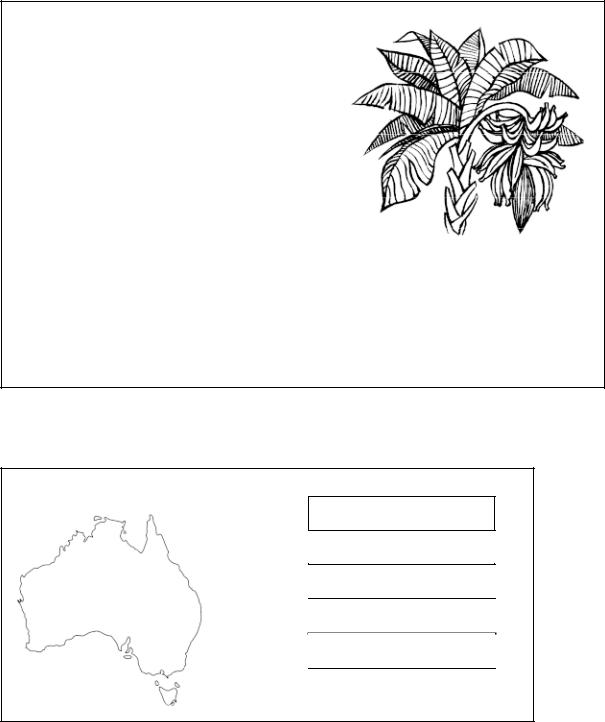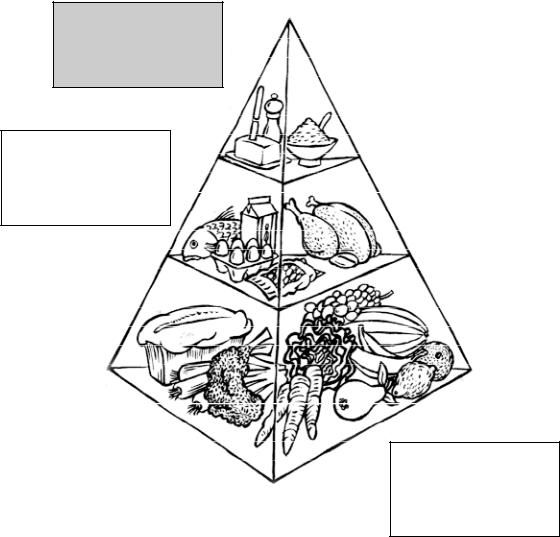
IELTS_
.pdf
Listening
SECTION 2 Questions 11-20
Complete the notes below. Use NO MORE THAN THREE WORDS for each answer.
There are many kinds of bicycles available:
racing touring
(11) ..............................................
ordinary
They vary in price and (12) ................................................ . |
|
Prices range from $50.00 to (13) ......................................... . |
|
Single speed cycles are suitable for (14) ................................ . |
|
Three speed cycles are suitable for (15) ................................. . |
|
Five and ten speed cycles are suitable for longer distances, hills |
|
and (16) ............................................. . |
|
Ten speed bikes are better because they are (17) ............................ |
in |
price but (18) ...................................... . |
|
Buying a cycle is like (19) ................................. . |
|
The size of the bicycle is determined by the size of |
|
the (20) ............................................. . |
|
35
Practice Test 2
SECTION 3 Questions 21-32
Questions 21-24
Circle the correct answer.
21 At first Fiona thinks that Martin’s tutorial topic is
Ainappropriate.
Bdull.
Cinteresting.
Dfascinating.
22According to Martin, the banana
A has only recently been cultivated. B is economical to grow.
C is good for your health. D is his favourite food.
23Fiona listens to Martin because she
A wants to know more about bananas. B has nothing else to do today.
C is interested in the economy of Australia. D wants to help Martin.
24According to Martin, bananas were introduced into Australia from
AIndia.
BEngland.
CChina.
DAfrica.
36

Listening
Questions 25-30
Complete Martin’s notes Use NO MORE THAN THREE WORDS for each answer.
Commercially grown banana plant
Each banana tree produces
(25) .......................................................
of bananas.
On modern plantations in tropical conditions a tree can bear fruit after (26) ............................................ .
Banana trees prefer to grow (27) |
......................................... and they require |
rich soil and (28) ..................................... . |
The fruit is often protected by |
(29) ............................................... . |
|
Ripe bananas emit a gas which helps other (30) .......................................... .
Questions 31 and 32
Circle the TWO correct boxes.
Consumption of Australian bananas
A Europe
B Asia
C New Zealand
D Australia
E Other
37

Practice Test 2
SECTION 4 Questions 33-41
Questions 33-35
Circle the correct answer
According to the first speaker:
33 The focus of the lecture series is on
A |
organising work and study. |
C |
coping with homesickness. |
B |
maintaining a healthy lifestyle. |
D |
settling in at university. |
34 The lecture will be given by
A |
the president of the Union. |
C |
a sports celebrity. |
B |
the campus doctor. |
D |
a health expert. |
According to the second speaker:
35 This week’s lecture is on
A |
campus food. |
C |
sensible eating. |
B |
dieting. |
D |
saving money. |
Questions 36-39
Complete the notes. Write NO MORE THAN THREE WORDS for each answer.
A balanced diet
A balanced diet will give you enough vitamins for normal daily living. Vitamins in food can be lost through (36) ............................................... .
Types of vitamins:
(a)Fat soluble vitamins are stored by the body.
(b)Water soluble vitamins - not stored, so you need a (37) ......................................................... .
Getting enough vitamins |
|
Eat (38) .................................................................... |
of foods. |
Buy plenty of vegetables and store them in |
|
(39) .................................................................................. |
. |
38

Listening
Questions 40-41
Complete the diagram by writing NO MORE THAN THREE WORDS in the boxes provided.
Example
Try to avoid
................................
sugar, salt and butter
40 ................................
.....................................
milk, lean meat, fish,
nuts, eggs
41 ................................
.....................................
bread, vegetables and
fruit
39

Practice Test 2
READING
READING PASSAGE 1
You should spend about 20 minutes on Questions 1-12 which are based on Reading Passage 1 below.
Right and left-handedness in humans
Why do humans, virtually alone among all animal species, display a distinct left or right-handedness? Not even our closest relatives among the apes possess such decided lateral asymmetry, as psychologists call it. Yet about 90 per cent of every human population that has ever lived appears to have been right-handed. Professor Bryan Turner at Deakin University has studied the research literature on left-handedness and found that handedness goes with sidedness. So nine out of ten people are right-handed and eight are right-footed. He noted that this distinctive asymmetry in the human population is itself systematic. “Humans think in categories: black and white, up and down, left and right. It”s a system of signs that enables us to categorise phenomena that are essentially ambiguous.’
Research has shown that there is a genetic or inherited element to handedness. But while left-handedness tends to run in families, neither left nor right handers will automatically produce off-spring with the same handedness; in fact about 6 per cent of children with two right-handed parents will be left-handed. However, among two left-handed parents, perhaps 40 per cent of the children will also be left-handed. With one right and one left-handed parent, 15 to 20 per cent of the offspring will be left-
handed. Even among identical twins who have exactly the same genes, one in six pairs will differ in their handedness.
What then makes people left-handed if it is not simply genetic? Other factors must be at work and researchers have turned to the brain for clues. In the 1860s the French surgeon and anthropologist, Dr Paul Broca, made the remarkable finding that patients who had lost their powers of speech as a result of a stroke (a blood clot in the brain) had paralysis of the right half of their body. He noted that since the left hemisphere of the brain controls the right half of the body, and vice versa, the brain damage must have been in the brain’s left hemisphere. Psychologists now believe that among right-handed people, probably 95 per cent have their language centre in the left hemisphere, while 5 per cent have rightsided language. Left-handers, however, do not show the reverse pattern but instead a majority also have their language in the left hemisphere. Some 30 per cent have right hemisphere language.
Dr Brinkman, a brain researcher at the Australian National University in Canberra, has suggested that evolution of speech went with right-handed preference. According to Brinkman, as the brain evolved, one side
40

Reading
became specialised for fine control of movement (necessary for producing speech) and along with this evolution came righthand preference. According to Brinkman, most left-handers have left hemisphere dominance but also some capacity in the right hemisphere. She has observed that if a left-handed person is brain-damaged in the left hemisphere, the recovery of speech is quite often better and this is explained by the fact that left-handers have a more bilateral speech function.
In her studies of macaque monkeys, Brinkman has noticed that primates (monkeys) seem to learn a hand preference from their mother in the first year of life but this could be one hand or the other. In humans, however, the specialisation in (unction of the two hemispheres results in anatomical differences: areas that are involved with the production of speech are usually larger on the left side than on the right. Since monkeys have not acquired the art of speech, one would not expect to see such a variation but Brinkman claims to have discovered a trend in monkeys towards the asymmetry that is evident in the human brain.
Two American researchers, Geschwind and Galaburda, studied the brains of human embryos and discovered that the left-right asymmetry exists before birth. But as the brain develops, a number of things can affect it. Every brain is initially female in its organisation and it only becomes a male brain when the male foetus begins to secrete hormones. Geschwind and Galaburda knew that different parts of the brain mature at different rates; the right hemisphere develops first, then the left. Moreover, a girl’s brain develops somewhat faster than
that of a boy. So, if something happens to the brain’s development during pregnancy, it is more likely to be affected in a male and the hemisphere more likely to be involved is the left. The brain may become less lateralised and this in turn could result in left-handedness and the development of certain superior skills that have their origins in the left hemisphere such as logic, rationality and abstraction. It should be no surprise then that among mathematicians and architects, left-handers tend to be more common and there are more left-handed males than females.
The results of this research may be some consolation to left-handers who have for centuries lived in a world designed to suit right-handed people. However, what is alarming, according to Mr. Charles Moore, a writer and journalist, is the way the word “right” reinforces its own virtue.
Subliminally he says, language tells people to think that anything on the right can be trusted while anything on the left is dangerous or even sinister. We speak of lefthanded compliments and according to Moore, “it is no coincidence that lefthanded children, forced to use their right hand, often develop a stammer as they are robbed of their freedom of speech”. However, as more research is undertaken on the causes of left-handedness, attitudes towards left-handed people are gradually changing for the better. Indeed when the champion tennis player Ivan Lendl was asked what the single thing was that he would choose in order to improve his game, he said he would like to become a lefthander.
Geoff Maslen
41

Practice Test 2
Questions 1-7
Use the information in the text to match the people (listed A-E) with the opinions (listed 1-7) below. Write the appropriate letter (A-E) in boxes 1-7 on your answer sheet. Some people match more than one opinion.
ADr Broca
BDr Brinkman
CGeschwind and Galaburda
DCharles Moore
EProfessor Turner
Example |
Answer |
Monkeys do not show a species specific preference for |
B |
left or right-handedness. |
|
|
|
1Human beings started to show a preference for right-handedness when they first developed language.
2Society is prejudiced against left-handed people.
3Boys are more likely to be left-handed.
4 |
After a stroke, left-handed people recover their speech more quickly |
than right- |
|
handed people. |
|
5 |
People who suffer strokes on the left side of the brain usually lose |
their power of |
|
speech. |
|
6The two sides of the brain develop different functions before birth.
7Asymmetry is a common feature of the human body.
42

Reading
Questions 8-10
Using the information in the passage, complete the table below. Write your answers in boxes 8 10 on your answer sheet.
|
Percentage of children left-handed |
|
|
|
|
One parent left-handed |
... (8) ... |
|
One parent right-handed |
||
|
||
|
|
|
Both parents left-handed |
... (9) ... |
|
|
|
|
Both parents right-handed |
... (10) ... |
|
|
|
Questions 11-12
Choose the appropriate letters A-D and write them in boxes 11 and 12 on your answer sheet.
11A study of monkeys has shown that
A monkeys are not usually right-handed. B monkeys display a capacity for speech.
C monkey brains are smaller than human brains. D monkey brains are asymmetric.
12According to the writer, left-handed people
A will often develop a stammer.
B have undergone hardship for years. C are untrustworthy.
D are good tennis players.
43

Practice Test 2
READING PASSAGE 2
You should spend about 20 minutes on Questions 13-27 which are based on Reading Passage
2 below.
MIGRATORY BEEKEEPING
TakingWing
To eke out a full-time living from their honeybees, about half the nation’s 2,000 commercial beekeepers pull up stakes each spring, migrating north to find more flowers for their bees. Besides turning floral nectar into honey, these hardworking insects also pollinate crops for farmers -for a fee. As autumn approaches, the beekeepers pack up their hives and go south, scrambling for pollination contracts in hot spots like California’s fertile Central Valley.
Of the 2,000 commercial beekeepers in the United States about half migrate This pays off in two ways Moving north in the summer and south in the winter lets bees work a longer blooming season, making more honey — and
money — for their keepers. Second, beekeepers can carry their hives to farmers who need bees to pollinate their crops. Every spring a migratory beekeeper in California may move up to 160 million bees to
44
